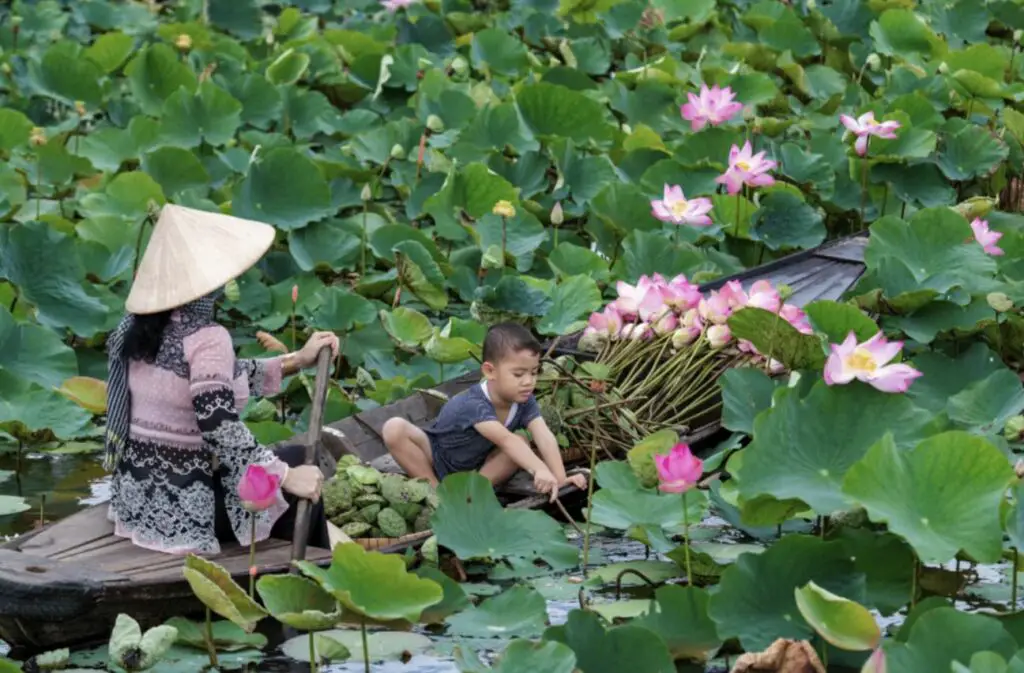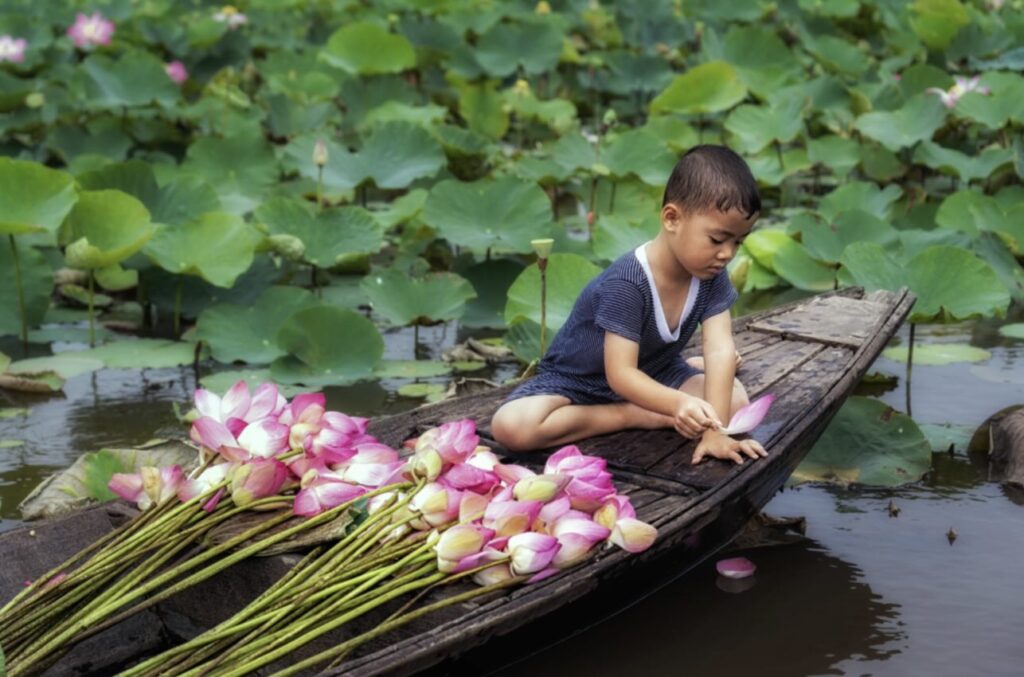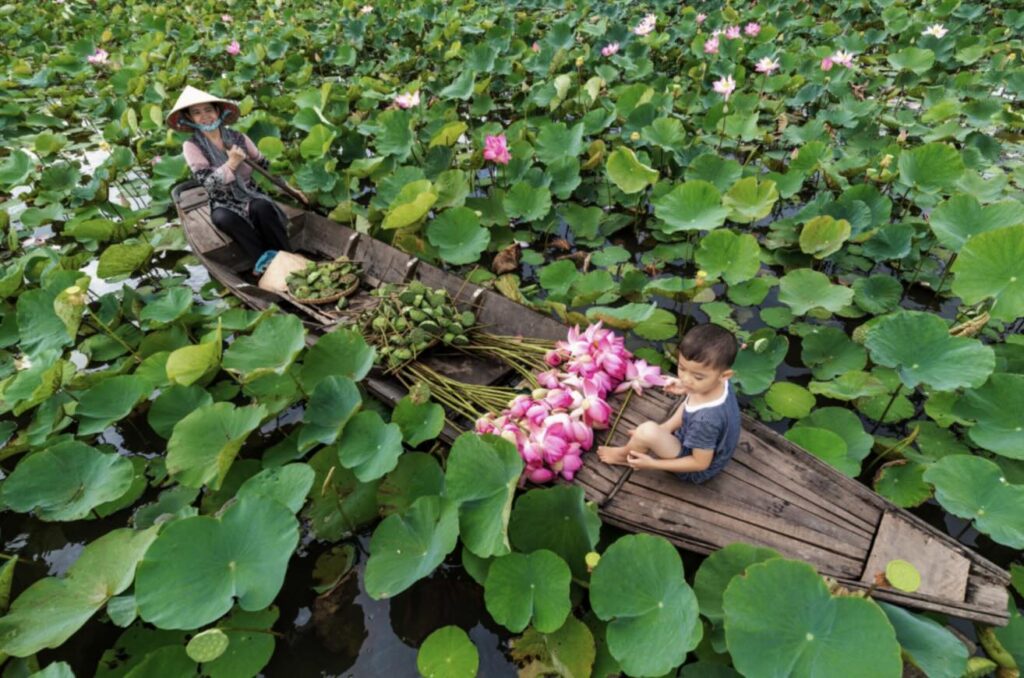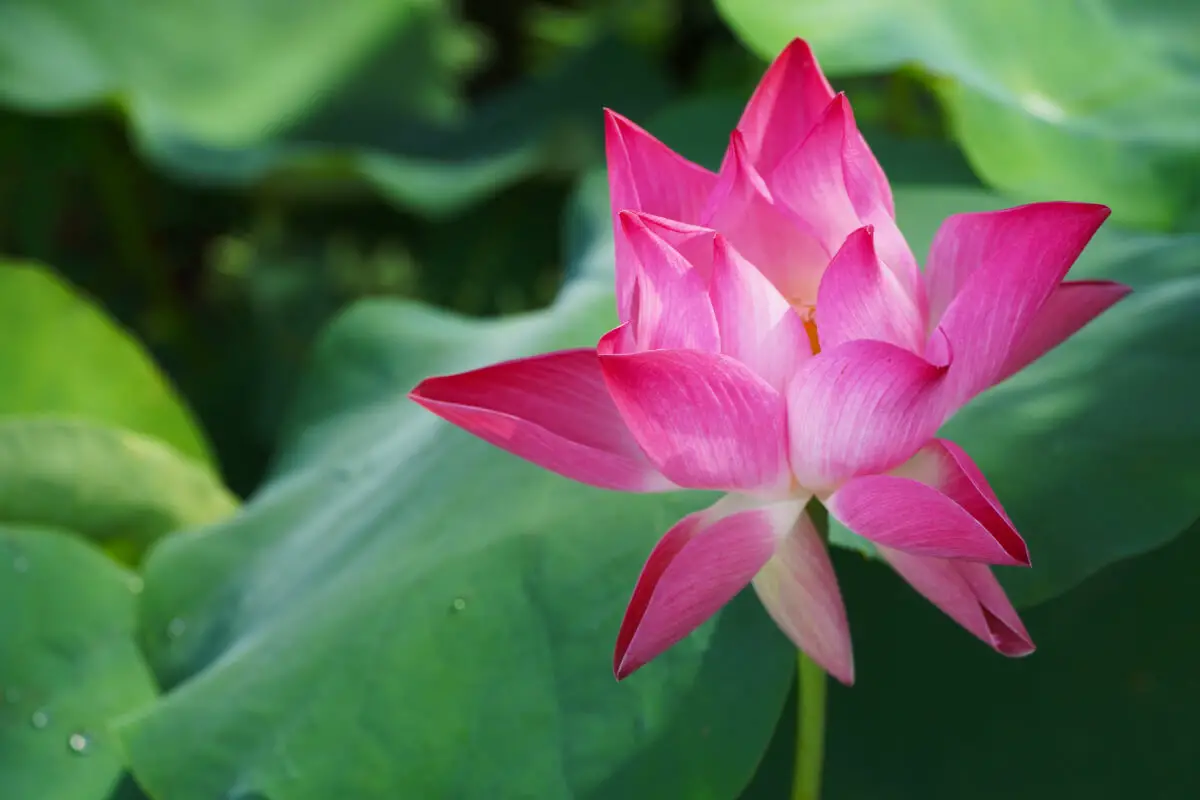Steeped in a mix of religion, folklore, and tradition, the Lotus is paramount in Vietnam’s cultural and spiritual fabric. This is more than just a flower; it is a quintessential symbol of Vietnamese resilience and grace, deeply rooted in the nation’s consciousness and depicted in virtually all forms of art and literature.
The Vietnamese Lotus, known scientifically as Nelumbo nucifera, graces the country’s landscapes with its ethereal beauty and is crucial in defining the nation’s gastronomy, agriculture, and tourism. The intricate threads of significance that this flower carries, from the muddy waters of its roots to the purity of its bloom, are woven into the tapestry of Vietnamese living — a journey of transcendence, transformation, and constant growth.
Table of Contents
- Symbolism of the Vietnamese Lotus
- Growing and Harvesting the Vietnamese Lotus
- Lotus-based Vietnamese Cuisine
- Lotus Tourism in Vietnam
- Related Questions
Symbolism of the Vietnamese Lotus
Unraveling the Allure of the Lotus: Vietnam’s Cultural Symbol Worth Exploring
There’s something magical about lotus flowers. As travelers, we’re used to observing nature’s extraordinary beauty, from the sea’s deep turquoise hues to the vibrant sunset’s vibrant color spectacle. But the Vietnamese Lotus goes beyond pure aesthetics – it packs a more profound cultural significance that resonates with millions of folks who call this Southeast Asian country home.
Consider this your go-to guide on the Vietnamese Lolotus’ intrinsic value beyond just stunning floral decor; this humble water plant is genuinely the heart and soul of Vietnam, and here’s why!
FiThe first step in understanding this phenomenon is the very core of the Lotus – the fact that it blooms pure and untainted despite growing in muddy waters. Ring a bell? That’s the exact representation of the incredible spirit of the Vietnamese.
Unfazed by their often harsh surroundings, they spring forth resilient, strong, and splendid. This symbolism has been deeply ingrained into everyday Vietnamese life and reflects in the people’s resilience, attitudes, and values.
Moving right along, let’s talk cuisine. Vietnamese street food? Yes, please! But did you know that almost every part of the Lotus – seeds, stems, flowers – finds its way into the local dietary habits? For instance, the seeds, or lotus nuts, become a delicious summer dessert when simmered in sugar syrup. Lotus tea, anyone? This lightly fragrant brew stands unmatched for its subtle yet full-bodied flavor, which thrives during celebration times.
We step away from survival necessities and move towards the spiritual realm; the Lotus is a quintessential symbol in Buddhism, the country’s most prevalent religion.
Referred to as the “flower of the dawn,” the Lotus is often seen in stunningly crafted motifs decorating Buddhist pagodas. This experience creates an unforgettable spectacle of art and spirituality blended.
One cannot overlook the role of this alluring flower in the arts and literature scene as well. The Vietnamese poets and painters have often used it as a muse, eulogizing its mesmerizing beauty and divinity in famous works. The Lotus is an omnipresent theme from traditional poetry to modern-day pop songs.
Lastly, let’s not forget the fashion. Lotus silk, though costly, is an absolute sensation in Vietnamese apparel. This luxurious fabric, curated from delicate lotus fibers, is silkier and lighter than traditional silk. Often linked with dignified status, this ethereal fabric is a testimonial to the Vietnamese’s impulse to transform their surroundings into something extraordinary.
There you have it! The Vietnamese Lotus, far from just a pretty face, is a profound representation of resilience, culture, spirituality, and artistry that beautifully keys into the Vietnamese way of life. Here is a flower that enriches the cuisine, adds serenity to religious rites, seduces poets and artists with its elegance, and even finds significance in a fashionista’s wardrobe.
Next time you find yourself in Vietnam, take a moment to delve deeper into the connection locals have with this humble yet captivating floral emblem. You never know; this might be the trip that turns an ordinary flower into a lifelong symbol of resilience and beauty for you, too!

Growing and Harvesting the Vietnamese Lotus
The Enchanting Evolution of the Vietnamese Lotus: An Intriguing Journey
Bathing under the warm sunlight and brimming with unique grace, the Vietnamese Lotus is a visual extravaganza. An iconic emblem of the country’s cultural fabric, it’s intriguing to dig deeper into its life cycle, cultivation, and distinctive characteristics.
The birthplace of this enchanting flora, Vietnam, is mirrored with ponds and lakes, radiating the vibrant hue of floating lotus flowers. Cultivating Lotus isn’t a mundane horticultural exercise but rather a passionate reverie. Farmers painstakingly plant these lotus seeds in clay-heavy loam around the banks of ponds or water-logged fields during the years’ cooler months. Each seed nestles within the mud, nurturing the promise of an enchanting flower.
Through the spring, bold green stalks rise above the water, basking in the crisp sunshine. As buds start to surface, the water’s surface is shrouded in an almost mystical green carpet, ready to bloom under the sun. Come summer, the spectacle unfolds with soft, rosy petals emerging from the bud in an effortless bloom.
This blooming process, a prominent metaphor for purity and rebirth in Vietnamese culture, is a mesmerizing day-long event, repeating itself for about three to five months a year.
Now, if the scenic lure wasn’t enough, the lotus plants come with a dash of uniqueness — they’re multipurpose. Every part of this plant, from the flowers and leaves to stems and seeds, finds a purpose. The lotus seeds, known as ‘hot sen,’ are a culinary delight, both eaten fresh or dried and used in various local dishes and sweets. Not just a treat to the palate, they also pack a potent health punch. High in antioxidants, they’re known to improve digestion and heart health and even boost mental wellness!
Transcending the realm of the gustatory, the petals of the Lotus are used in the creation of an exquisite type of tea. Lotus petals are picked at dawn and then used to infuse dried tea leaves with their fragrant essence—a delicate process worthy of a separate saga altogether. When served steaming, this lotus tea promises an authentic Vietnamese experience—an aromatic elixir that delights the senses.
Finally, the visually stunning lotus stalk is long, strong, and pleasingly pink. Once the flower has bloomed and faded, the stalks are harvested, bound, and dried. These minimalist yet captivating bundles known as ‘hot ngó dong’ have become a visual staple in Vietnamese homes, adding a touch of ethereal beauty to their surroundings.
In essence, the journey of the Lotus in Vietnam, from cultivation to practical usage, is not just a tale of botanical growth but a rich narrative of tradition, artistic vision, and resourceful living. So, the next time you find yourself entranced by the serene beauty of a lotus, remember that there’s a fascinating tale pulsing under its soft petals.

Lotus-based Vietnamese Cuisine
Dive right in with us as we explore the world of the lotus flower in Vietnamese delicacies, where it transforms from a symbol of purity into a delightful culinary experience. Across Vietnamese kitchens, every part of the Lotus — its plump seeds, crisp stems, aromatic leaves, and magnificent petals — are woven into delicious gastronomical tales to be told and tasted.
One cannot speak of Lotus and Vietnamese cuisine or mention “Chè Sen,” a traditional dessert soup. Evoking memories of grandmothers stirring large pots over wooden stoves, this soup is sweetened to perfection using sugar or coconut milk. The hearty lotus seeds take center stage, simmered until tender, curating a delightful flavor balance.
Sold in traditional markets or hawked from baskets hanging from a bamboo shoulder pole (a scene right out of a picturesque watercolor painting!) is “Bánh đa lạ,” a unique lotus-flavored treat. If you’re thinking, “Just a rice cracker?” hold your thought! Unassuming yet packed with character, these circular crackers carry a distinctive lotus leaf flavor, adding an exotic twist to a simple snack paired with dips and sauces.
“Sen cuốn tôm thịt” brings together the crunch of fresh Lotus stems and succulence of shrimp and pork. This refreshing salad includes morsels of shrimp and pork with enticing textures of Lotus stems and unifies the ingredients under the tanginess of a fish sauce dressing.
Sample the delectable “Gà nấu cháo sen” for a fantastic fusion of flavors, delicate yet bold. Known as a traditional Vietnamese favorite, this lotus seed porridge with chicken promises a well-rounded gastronomic experience for any adventurous taste buds. Replicating the traditional preparation at home brings a hearty meal to the table, as the chicken is cooked until tender, with hand-scouted lotus seeds simmering alongside, fusing their sweetness with the savory broth.
Experiencing Vietnamese cuisine is incomplete without savoring “Chè sen trân châu.” This sweet soup dessert, boasting boba-like tapioca pearls and tender lotus seeds, promises a medley of textures and an indulgent sweetness.
Finally, lose yourself in the intoxicating aroma and spiritual tranquility offered by “Trà sen,” or Vietnamese Lotus Tea. Dessert-like sweetness, married with a refreshing, floral fragrance, sets this beverage apart. The labor-intensive process requires the petals to be stuffed with high-quality tea leaves and folded back carefully to allow the Lotus’s natural scent infusion.
Behind the humble exteriors, every bit of the Lotus promises an untold narrative, a sensory symphony conducted by Vietnamese cuisine maestros. An exotic allure, rich with culture and history, waiting for you to unpack as you journey through Vietnam and its kitchens. Now go on, add these dishes to your culinary bucket list!

Lotus Tourism in Vietnam
Venture right into the heart of Vietnam’s vibrant culture and unveil the beauty of this divine flower woven throughout Vietnamese society by exploring the places traditionally celebrated the most.
Dive into the Lotus Season at the West Lake of Hanoi, where hundreds of enchanting lotus flowers bloom from June to August, painting the lake’s surface with a surreal beauty that would inspire any artist or photographer.
Embark on the well-kept secret Tinh Khe, where ‘Tra Sen,’ the Lotus Tea, fills the air with its mild fragrance, and every sip takes you back to a simpler time. Created by filling lotus blossoms with green tea at night, then collected at the break of dawn to ensure maximum absorption of the flower’s fragrance, it’s a wonder that screams Vietnamese legacy.
Or, feed into Vietnam’s spiritual side by heading to lotus ponds surrounding Buddhist pagodas. The most famous of them all is the One Pillar Pagoda in Hanoi. Its unique lotus-based architecture fuels the eloquent confession of faith and belief of the citizens. Lotus flowers blooming around it provide a backdrop of tranquility and introspection.
Cheap flights from Hanoi or Ho Chi Minh City will lead you to Đồng Tháp Province in the Mekong Delta – another prominent lotus hub. Let your senses get lost in the ‘Thap Muoi Lotus Fields,’ which stretches over 75 acres. An early morning visit will reveal lotus flowers opening their petals and greeting the sun, while the early afternoon will see them close, bidding the day goodbye.
Venture down to South Vietnam and find yourself in Hồng Ngự District, where a relatively new lotus field has already become quite the spectacle, covering a massive area of around 100 hectares. This location is breathtaking during sunrise and sunset, painting the sky with orange and pink hues reflecting off the surrounding water surface.
The time-honored tradition of creating silk from lotus stalks can be explored at the mesmerizing ‘Lotus Silk Village’ of Quang Nam Province. The labor-intensive process of extracting silk threads from thousands of Lotus stems happens right before the eyes, transforming into the stunning yet wearable art form that characterizes the Vietnamese fashion landscape.
Therefore, exploring the Vietnamese Lotus is more than just viewing a flower. It’s tasting a delightful tea, getting lost in enchanting ponds, walking amid lush fields, connecting with spiritual roots, and learning a craft. It’s an immersion into a piece of Vietnam. The Lotus, a symbol of purity, majesty, and elegance, is an experience only found in the heart of this prosperous and diverse country.

So, the lotus’ reach extends much further than being a visually pleasing element of Vietnam’s natural flora. Beyond symbolizing spiritual enlightenment and being a recurring theme in arts, it is also a cornerstone of local cuisine and a vital source of income and tourism for the country.
From the serene fields of blooming lotus flowers that provide a scenic vista to the traditional dishes that offer a unique culinary experience, the Vietnamese Lotus forms an unbreakable link with the country’s identity. Its resounding significance is a testament to how nature, in its simplicity, can foster resilient cultural narratives and continue to inspire and influence a nation through the ages.
At A Bus On A Dusty Road, we talk about everything about travel, life, and ex-pat living. We are all about “Living Life As A Global Citizen.” We explore social, cultural, and economic issues and travel.
We would love to have you be part of our community. Sign up for our newsletter to keep up-to-date by clicking here. If you have any questions, you can contact me, Anita, by clicking here.
Listen to our Podcast called Dusty Roads. You can find it on all major podcast platforms. Try out listening to one of our podcasts by clicking here.
Subscribe to our A Bus On A Dusty Road YouTube Channel with great videos and information by clicking here.
Related Questions
How Similar Are The Chinese And Vietnamese Languages?
Vietnamese and Chinese are Asian languages though they come from different language families. Vietnamese and Chinese are both tonal languages and have similar sentence structures. They are monosyllabic languages, meaning that one word has one syllable, and several dialects are spoken.
By clicking here, you can discover How Similar Are The Chinese And Vietnamese Languages?
What Is The Official Language Of Hong Kong?
The official language of Hong Kong is Chinese and English. The residents of Hong Kong are native Cantonese Chinese speakers, so the official language is Cantonese Chinese. Many in Hong Kong can also speak Mandarin Chinese; many local Hong Kong residents prefer to speak Cantonese Chinese or English.
By clicking here, you can discover What Is The Official Language Of Hong Kong?
Vietnam Or Thailand, Which Country Is Better For Living?
Deciding between living in Vietnam or Thailand can be a difficult choice, as both countries offer unique opportunities for ex-pats and locals alike. With dynamic cultural influences, an exciting nightlife scene, and stunning natural attractions, it can be hard to decide which country is ultimately better. Read on to help you make a decision as to which place you should consider.
By clicking here, you can discover Vietnam Or Thailand, Which Country Is Better For Living?


